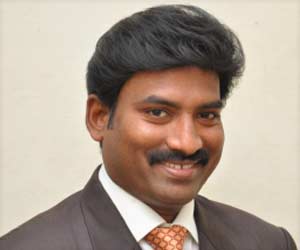- The lead aprons used by X-ray technicians are heavy and are often remain unused.
- Dr. Senthil Kumar designed aprons that are 20% lighter and 25% better at shielding the body from radiations.
- Such innovative designs will help improve the safety of health care workers.

Moving from being a little known professor, to one who has shot to fame across various social media channels, Dr. Senthil Kumar seems humbled by the attention showered on his design. The newly designed apron is a mixture of Antimony, Bismuth and Barium Sulphate, along with an elastic polymer that could be fabricated into thin sheets, which makes the garment light and easy to wear. When asked what motivated the professor to design the new apron, Dr. Senthil said “The personnel working with X rays find it difficult to wear the conventional lead apron and sometimes they are comfortable to work with x rays without wearing lead aprons because of its heavy weight. This motivated me to make a new lighter lead equivalent apron and to provide more attenuation of radiation
Award Winning Design
The design came to light during the National Symposium on Medical Physicals, conducted by the Association of Medical Physicists of India at Aditya Birla Memorial Hospital in Pune (2017) where Dr. Senthil won the ‘Best Innovation Award’. “The newly designed apron is 20% light weight, 25% more radiation attenuation when compared with the conventional lead apron,” he said as he went on to point out how he will be applying for a patent soon with the Atomic Energy Regulatory Board.Reaching Markets Soon
The young researcher cum radiologist plans to present the paper at International conferences, hoping to create greater awareness. 5 years of constant research and repeated efforts has gone behind developing this new design and hopefully, it would soon become accessible to many. “I am going to market with my product in collaboration with reliable companies so as to reach the users.” This is expected to be Dr. Senthil’s next step forward, as there is a lot of market research and preferences that need to be addressed. However, he remains hopeful. “It will take 1 month to 3 months for my product to be available in market.This apron has numerous benefits over the traditional lead apron, one of them being less expensive. The apron costs only 10,000 when compared to Rs 80,000 for the lead aprons. Moreover, the lead aprons need to be tested once every year to ensure that there is no leakage but the newly designed aprons need to be tested only after 3 years. This makes them far more durable, easier on the pocket and would, hopefully, encourage X-ray technicians to keep it on.
The novel design developed by this radiology professor is a considerable step towards safeguarding the safety of technicians, working across many imaging centers, bringing to the fore the importance of constantly innovating to improve designs. The quest for improving healthcare is not limited to a few, but lies in the hands of people who understand the needs. Dr. Senthil Kumar’s achievement lies not only in the newly designed apron but also in his strong resolve to find a solution for lab technicians, who risk their lives to help others. When asked what message he has for people who wish to innovate, he says, matter of factly, “Keep trying till the goal is achieved.”
Source-Medindia









